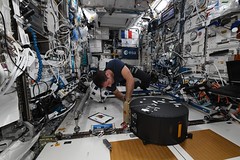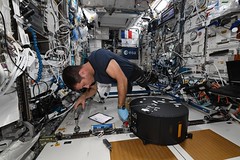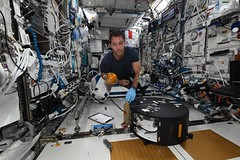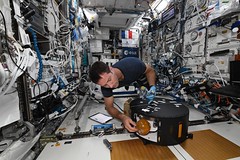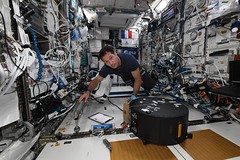Fluidics 3
mardi 8 juin 2021 à 17:12Thomas Pesquet posted a photo:
I got out an old friend that I haven't seen since Proxima, the CNES experiment Fluidics! I installed it in 2017 during Proxima and since then eight astronauts have set it up for research. This box holds six spheres with liquid that slosh about up here in weightlessness and are recorded by cameras for researchers to observe – but only one sphere at a time. The experiment has two very different but also somewhat similar benefits: it will help satellite and rocket designers understand how fuel behaves in their tanks (and help them get all the fuel into their thrusters, effectively improving their mileage) as well as help researchers understand ocean currents (and our climate). As today is World Oceans Day let's look at the ocean currents . Like all science it is helpful for researchers to isolate factors and investigate them. It is easier to understand how light travels if you research it in a darkened room for example. With Fluidics researchers are trying to understand how water currents form and behave, without gravity influencing them. The results will isolate the factors at play and help us understand the phenomena on a larger scale. Ocean currents are important for everything from fish migration, to plastic pollution of our seas and even shipping efficiency.
I got out an old friend that I haven't seen since Proxima, the CNES experiment Fluidics! I installed it in 2017 during Proxima and since then eight astronauts have set it up for research. This box holds six spheres with liquid that slosh about up here in weightlessness and are recorded by cameras for researchers to observe – but only one sphere at a time. The experiment has two very different but also somewhat similar benefits: it will help satellite and rocket designers understand how fuel behaves in their tanks (and help them get all the fuel into their thrusters, effectively improving their mileage) as well as help researchers understand ocean currents (and our climate). As today is World Oceans Day let's look at the ocean currents . Like all science it is helpful for researchers to isolate factors and investigate them. It is easier to understand how light travels if you research it in a darkened room for example. With Fluidics researchers are trying to understand how water currents form and behave, without gravity influencing them. The results will isolate the factors at play and help us understand the phenomena on a larger scale. Ocean currents are important for everything from fish migration, to plastic pollution of our seas and even shipping efficiency.
Credits: ESA/NASA–T. Pesquet
607C7707
